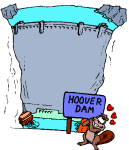

Hydroelectric Power
 On Earth, water is neither created nor destroyed, but is constantly moved around. Water evaporates from the oceans and other freshwater bodies such as rivers and lakes, and is stored by the atmosphere. Under certain weather conditions water vapour in air condenses to form clouds, and eventually precipitates out as rain, snow, sleet and hail. This precipitation collects into streams and rivers, and flows back to the sea. This is known as the water cycle.
On Earth, water is neither created nor destroyed, but is constantly moved around. Water evaporates from the oceans and other freshwater bodies such as rivers and lakes, and is stored by the atmosphere. Under certain weather conditions water vapour in air condenses to form clouds, and eventually precipitates out as rain, snow, sleet and hail. This precipitation collects into streams and rivers, and flows back to the sea. This is known as the water cycle.
All this movement provides an enormous opportunity to create useful energy. Hydroelectric power (HEP) uses the force of moving water to create electricity. However, HEP stations often require large dams, which can disrupt ecosystems and displace people.
Large-scale HEP currently accounts for about 20% of the world's electricity supply. In the UK this percentage is much smaller, but there are a number of large-scale HEP stations currently in operation. In Scotland they are responsible for providing a significant amount of energy. Unfortunately there is little room for the future development of large scale HEP stations in the UK and so the potential of small-scale HEP stations is now being investigated.
 | Hydroelectric dam |
Websites
Other topics
• Schools Database
• Education Site
• dti Renewable Energy
• US Dept. of Energy
• Renewable Energy Project
• Introduction
• Agenda 21
• Agriculture
• Air Pollution
• Biodiversity
• Biofuels
• Brundtland Report
• CHP
• Conservation/Preservation
• Cycling & Walking
• Doing Our Bit
• Earth Summit
• Energy
• Energy Efficiency
• Energy from Waste
• Forests
• Fossil Fuels
• Geothermal Energy
• Human Health
• Hydroelectric Power
• Indicators
• Land Use Planning
• Local Agenda 21
• Nuclear Power
• Population
• Poverty
• Power Generation
• Public Transport
• Renewable Energy
• Solar Energy
• Sustainable Development
• Tidal Power
• Transport
• Transport Impacts
• Transport Solutions
• UK Strategy
• Waste
• Waste Disposal
• Waste Recycling
• Water Quality
• Wave Power
• Wind Power
 Print Topic
Print Topic